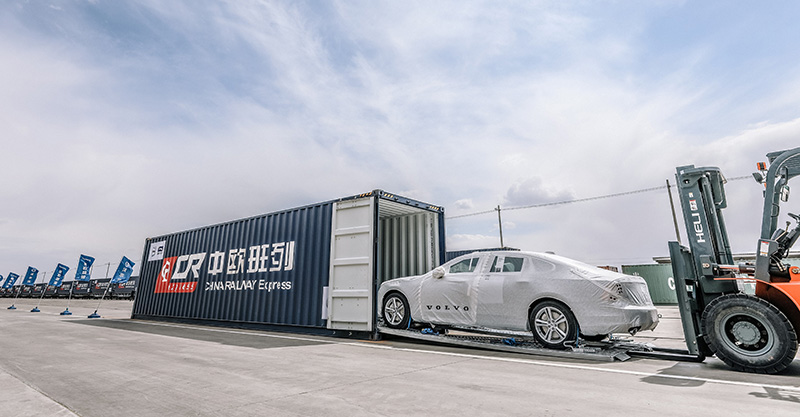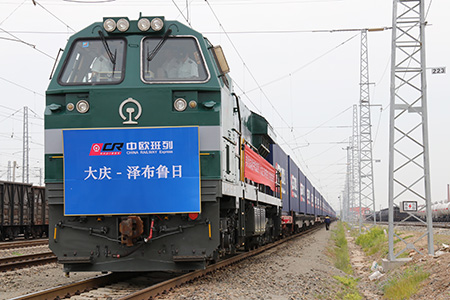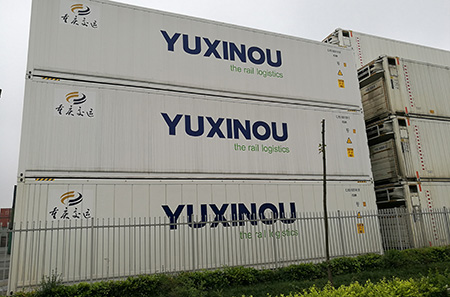 China and Europe are far apart, not just in terms of distance, but also culturally, economically and politically. Yet they occupy the same Eurasian land mass and trade between the two regions has been growing strongly. That includes automotive freight, with parts and vehicles moving in greater numbers in both directions. In recent years, rail has also been playing a greater role in this trade, with companies turning to it as a faster option than sea, and a cheaper option than air. Automotive freight along rail routes is growing in particular – with some estimates that the industry represents 15% of the goods moved by rail between China and Europe.
China and Europe are far apart, not just in terms of distance, but also culturally, economically and politically. Yet they occupy the same Eurasian land mass and trade between the two regions has been growing strongly. That includes automotive freight, with parts and vehicles moving in greater numbers in both directions. In recent years, rail has also been playing a greater role in this trade, with companies turning to it as a faster option than sea, and a cheaper option than air. Automotive freight along rail routes is growing in particular – with some estimates that the industry represents 15% of the goods moved by rail between China and Europe.
China is supporting the growth of rail through its ambitious ‘One Belt, One Road’ economic and trade plan. The initiative is designed to boost infrastructure and China’s trade links with Europe, Asia and Africa across overland and maritime links. In May this year, China’s president Xi Jinping announced investments of $124 billion toward further developing transport and logistics links across the ‘New Silk Road’. That money, supported by private investment in new services, is already bringing benefits to carmakers looking more to moving their products by rail.
Going all aboardOne of those carmakers is Volvo Cars, which has just started moving S90 vehicles made at its plant in Daqing, China, to Zeebrugge port in Belgium. Volvo, majority-owned by Chinese carmaker Zhejiang Geely, is the first carmaker to use regular rail shipments of finished vehicles between China and western Europe.
The service is managed for Volvo Cars by Beijing Changjiu Logistics and HAO International Logistics, a joint venture between Beijing Changjiu Logistics, the port of Dalian, and the Harbin Railway Bureau. Beijing Changjiu handles exports by rail to Europe and has confirmed that 12,000 vehicles will be moved on the service per year. It sees the use of Zeebrugge port as a great opportunity for future business and its establishment in Europe. The company has invested 80m yuan ($12.3m) in the Volvo project, including 50m yuan for a special vehicle racking system provided via Changjiu subsidiary CDC International; 20m yuan for a container-loading warehouse in Daqing; and another 10m yuan for other various equipment and systems.

Chen Gang, managing director of Changjiu, hopes to provide long-term services to Volvo and others for return shipments as well. “For automotive customers in general, we hope to further develop our capabilities and service level to offer top-notch products on both westbound and eastbound routes,” says Chen. “We are continuously developing our network both in Europe and in China to further facilitate this objective.”
Dongfeng Passenger Vehicle Company (DPVC) is another carmaker based in China shipping vehicles out of the country by rail. The company, which is a subsidiary of Dongfeng Motor, based in Wuhan, is moving finished vehicles by rail from China to Russia via a route serving Wuhan and Manzhouli, China, and Zabaikalsk, Votkinsk and Moscow, Russia. Daisheng Peng, manager of the vehicle logistics office, says: “We use rail due to its reliability, carriage capacity, transport speed and price advantage.”
Peng predicts that China’s ‘One Belt One Road’ plan will increase trade rapidly with countries along the new Silk Road. “Railway transportation will play a leading role in these trades,” he says.
Peng points out that the China Railway Express Company has opened up new pathways by connecting China and the countries along the ‘Belt and Road’ initiative with Europe. At present, there are 51 routes from 27 locations across China, which reach 28 cities in 11 European countries. As of summer 2017, more than 3,200 shipments had been completed.
A transcontinental ambitionAlong with the finished vehicle shipments it handles for Volvo, Changjiu is also working with Wuhu-based Chery Automobile – which owns 30% of CDC – to ship vehicles to Russia, and has been shipping a smaller number of test vehicles and other sensitive freight between Europe and China. The company began shipping knockdown parts to China by rail for Audi in 2014, which was the start of its regular service on the northern route. Other routes have been developed throughout 2016 and 2017.
Most rail freight shipped by Changjiu is for the automotive sector. However, HAO International Logistics, which is primarily a railway operator, handles goods for other sectors, including textiles from China to Europe and raw materials from Russia to China. “Although we are fully focused on automotive freight, in looking at the overall picture, non-automotive freight is, of course, important to all rail operators as it helps stabilise the bi-directional trade flows,” says Chen. “We do view automotive, as well as electronics, to be the most important segment for the transcontinental railway in the years to come.”
"Non-automotive freight is, of course, important to all rail operators as it helps stabilise the bi-directional trade flows [however we do see] automotive, as well as electronics, to be the most important segment for the transcontinental railway in the years to come." - Chen Gang, Beijing Changjiu Logistics
Global cargo transport and logistics provider APL Logistics is also providing rail services for finished vehicles and Scott Zheng, head of automotive logistics for North Asia, points to the delivery lead time benefits of rail, which he thinks is ultimately more reliable than ocean freight.
“Our service offers 50% transit time savings for automotive freight,” he says. As to reliability, he suggests that ocean transport is more susceptible to weather conditions than is rail transport. “However, rail also has some limitations because it does not transport dangerous goods,” admits Zheng.
APL Logistics’ automotive freight volume on the China-Europe trade lane is small compared to retail and consumer commodities, and it only began this past summer. However, Zheng says APL Logistics experienced a ten-fold increase in rail freight between Germany and China between 2015 and 2016. Two of the main reasons are shorter lead times and lower inventory costs.
A third reason is improved communication among railway operators. “Two years ago, communication involving the transfer between rail gauges was poor but now it is smoother,” says Zheng. “This is important because cross-continental Eurasia is the longest rail route in the world and involves a minimum of two gauge switches. Now the service is better and the transit time has stabilised. Even so, the rail hubs on both sides of borders, such as China-Kazakhstan, must be modernised.”
According to Chen Gang, the rail route in which Changjiu is most competitive is the one operated by HAO International Logistics of Harbin, Heilongjiang Province, in north-east China. This route is destined for Malaszewicze, Poland, Duisburg and Hamburg, Germany, and now also Zeebrugge for the Volvo Car shipments. This route interchanges at the border crossing of Manzhouli and Zabaikalsk at the China-Russia border, and at Brest between Belarus and Poland. Chen says station-to-station transit time is approximately 18 days, with the total transit time door-to-door varying between 20 and 23 days.
Beijing Changjiu Logistics also has partnerships with other operators, through which it ships cargo to and from Chengdu, Chongqing, Wuhan and Zhengzhou, amongst others. For these routes, it uses the border crossing at Alashankou and Dostyk between China and Kazakhstan. Final destinations in Europe include Lodz and Warsaw in Poland, and Rome, Italy. “We are also working on setting up a route from China to Iran to service parts for Chery Automotive, and we hope to provide service to other clients on this route in the future,” he says.
APL Logistics’ rail service, known as the Eurasia Rail Link, follows two primary routes. The northern route uses the Trans-Siberian Railway and runs to northern Mongolia, whereas the southern one runs through Kazakhstan, Belarus, and Russia. Zheng says that on average, both routes take 16-19 days to complete the 10,000-12,000km journey from China to Europe. On the northern route, the cities served in China, from east to west, include Shenyang, Changsha, and Suzhou, and in Europe they include Malaszewicze and Warsaw, Poland, and several locations in Germany as well as Spain and the UK. The southern route calls at the Chinese hubs of Zhengzhou, Yiwu, Chongqing, Chengdu and Wuhan, and the same European cities as the northern route.
Among its specific shipments, APL Logistics is handling automotive components for a tier two supplier from its factory near Duisburg to a tier one supplier’s plant in Chongqing using the southern route.
Rail vying with sea and airRZD Russian Railways-owned logistics provider Gefco has also launched a new multimodal China-Europe service this summer, this one between Germany and China via the port of Riga in Latvia. The company is shipping 52 40ft-equivalent units, with lead times ranging from 14-16 days, combining rail with barge and short-sea, plus road for last-mile delivery. Gefco is also providing customs clearance as part of the service. Containers for loading in Germany, as well as railway equipment in Riga, are provided by Transcontainer JSC and Gefco Baltic. Latvian Railways and Russian Railways support container rail shipments from Riga to China.
[mpu_ad]Laurent Sik, managing director for Gefco China, says that since the fourth quarter of 2015, the company has been importing finished vehicles by rail container for a few OEMs from European plants to China. This multimodal door-to-door solution offers a faster passage than ocean transport. “The objective is to make the supply chain more competitive. To that end, rail is now beginning to be seen as a backup for air transport. Thus, customers that shipped by air and sea are replacing air with rail.”
Within the past 21 months, Gefco has shipped BMW, Volvo Car, Volkswagen and PSA Group vehicles. Sik adds that in 2016, Gefco China imported 760 finished vehicles and 484 motorcycles on YuXinOu Railway, making it the largest LSP to import finished vehicles on the rail route from Duisburg to Chongqing. On this route, transhipment occurs in Brest, Belarus and Alashankou, China, on the Kazakhstan border.
Along with Chongqing, Chengdu is the only other city that the Chinese government allows to receive finished vehicle imports by rail. By contrast, for automotive parts and other dry cargo, many dry ports are permitted to handle imports.
Advantages of YuXinOu“Among the advantages of the YuXinOu railway is its strategic location, which covers western China and south-west China, thus shortening last-mile distribution and reducing costs,” says Sik. “The rail container with rack system optimises the load factor to three to four vehicles instead of two per container, thus reducing shipping costs.”
Another benefit is that the lead time is 17 days from station to station and in some cases, Gefco has even cut that time.
“Gefco achieved the shortest lead time of 14 days last year when we imported 160 units of BMW vehicles,” Sik points out. “Furthermore, the block train could consist of both automotive products – finished vehicles and parts – and non-automotive products, thus reducing shipping costs. Additionally, the increasing cost of sea freight is reducing the gap with rail costs on a door-to-door basis, in particular for final destinations that are located in western China.”
Central China and western China are located far from ports. Rail helps save on last-mile transport from port to final destination. Furthermore, trucks cannot enter Kazakhstan from China; they must be transhipped. Although railcars must change gauge at this border, it is easier to tranship 40 containers by rail than by truck. Sik says that Gefco’s potential customers for the Europe-China rail service are ones that manufacture high-value products or place a high priority on door-to-door transport lead times.
 Gefco is moving 40ft-equivalent containers from Transcontainer JSC and Gefco Baltic on 14-16 day journeys from Germany to China via the Latvian port of Riga
Gefco is moving 40ft-equivalent containers from Transcontainer JSC and Gefco Baltic on 14-16 day journeys from Germany to China via the Latvian port of RigaWhat is more, according to Sik, all vehicles destined for western China from Europe are most likely to go by rail. This is for a number of reasons, including the fact that when OEMs launch new models, rail covers the market more quickly than other modes. Electric vehicles are also most likely to use rail because ocean takes a long time and that means batteries can run down.
Questions of cost and capacityWhile there is progress on the route, there is room to improve its operations and equipment if rail services are to compete better with ro-ro shipping in future. For now, that cost divide remains quite wide – with rail up to five times more expensive than ro-ro.
One issue is that rail must use containers, which require more loading time and handling than wagons onto which vehicles can be driven. Chen Gang says that for some time, Changjiu Logistics looked into the possibility of shipping finished vehicles using ro-ro rail wagons rather than containers with racks, but it was ultimately deemed inadequate. “The lead time and handling points for each vehicle would increase drastically,” says Chen.
That is because of the gauge change between China and Russia or Kazakhstan, and again at the Belarus–Poland border. Chinese and European wagons have the same gauge width, but the CIS railways have a broader gauge, making it difficult to use the same equipment throughout the entire journey.
“However, through our Volvo Cars exports, we are introducing a large quantity of vehicle racks that optimise the loading capacity for finished vehicles per container. We are looking to build on this to further facilitate efficient railway transport of finished vehicles both for Volvo Cars and for other interested parties,” explains Chen.
Regarding cost savings, he says the rule of thumb at Changjiu is that rail freight offers a 50% time saving over sea freight and an 80% cost saving over air freight, though that does, of course, depend on where the final destinations on both sides are.
According to Zheng at APL, the price differential between ocean and rail modes varies. One element that determines the price of transport is the existence of a backhaul. “Not every route has a backhaul,” says Zheng. “For our China-Europe rail routes, three out of nine have backhauls. However, 80% of our routes to Europe do have backhauls to China.”
 Scott Zheng of APL Logistics says a lack of backhauls between China and Europe is an important factor in price differentiation with ocean transport
Scott Zheng of APL Logistics says a lack of backhauls between China and Europe is an important factor in price differentiation with ocean transportHe adds that its Eurasia Rail Link service is concentrated on the backhaul from Europe to China for both finished vehicles and auto parts. German car manufacturers lead the way. APL Logistics’ finished vehicle shipments are mainly mid to high-end passenger cars for the Chinese market, and auto parts range from steel plates to core components.
Despite shipping opportunities becoming more feasible, rail freight is still underdeveloped in China. Resources are controlled by state-owned subsidiaries, resulting in a more restrictive and costly environment. “For international transportation, rail freight is five times more expensive than ocean, on average,” he says.
“However, although ro-ro service is still the mainstream transport solution for finished vehicles because of its competitive cost and large capacity, containerised rail freight is an option for small batch and high frequency, transit-time sensitive and just-in-time shipments. Furthermore, the growing network and frequency of rail service is translating into higher volumes,” explains Zheng.
Peng at Dongfeng points out that a disadvantage of rail transport is that its mobility is poor and inflexible for shipping. “Nevertheless, it is an inevitable trend to form an integrated railway transport network on the Eurasian continent. These obstacles will become less of a barrier as time goes on,” he predicts.
According to sources at Volvo Cars, which declined to comment further for this article, the faster lead times offered by the China-Europe express rail service support inventory cost savings that ultimately make the rail option competitive for the specific models from China, compared to moving them by ro-ro.
Sources in China also indicate that some logistics companies and manufacturers are eligible for government subsidies in using the rail service, which also helps to make it more competitive, though this isn’t something most companies wished to comment on.
Whether as a direct alternative to ocean shipments on certain routes or as a greater part in a multimodal solution for faster and more cost-effective vehicle shipments between China and Europe, rail looks set to play a bigger part in automotive trade as China’s wider One Belt, One Road initiative gathers pace.
Additional reporting by Marcus Williams
 "The objective is to make the supply chain more competitive. To that end, rail is now beginning to be seen as a backup for air transport. Thus, customers that shipped by air and sea are replacing air with rail." - Laurent Sik, Gefco China
"The objective is to make the supply chain more competitive. To that end, rail is now beginning to be seen as a backup for air transport. Thus, customers that shipped by air and sea are replacing air with rail." - Laurent Sik, Gefco China


























![Global[1]](https://d3n5uof8vony13.cloudfront.net/Pictures/web/a/d/s/global1_726550.svgz)











